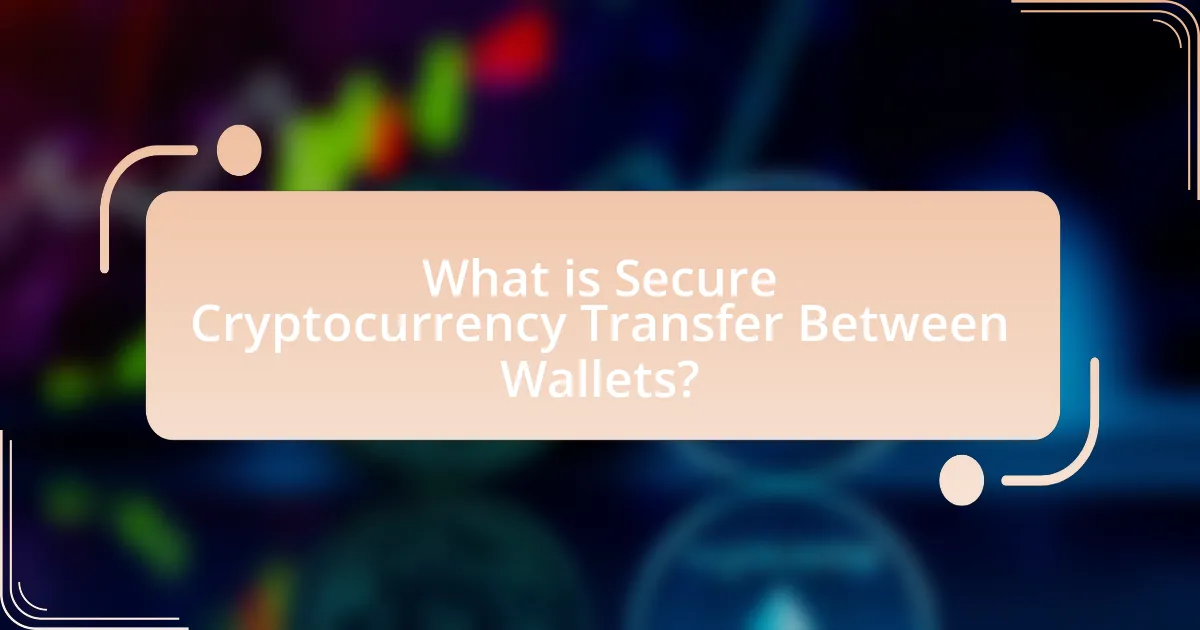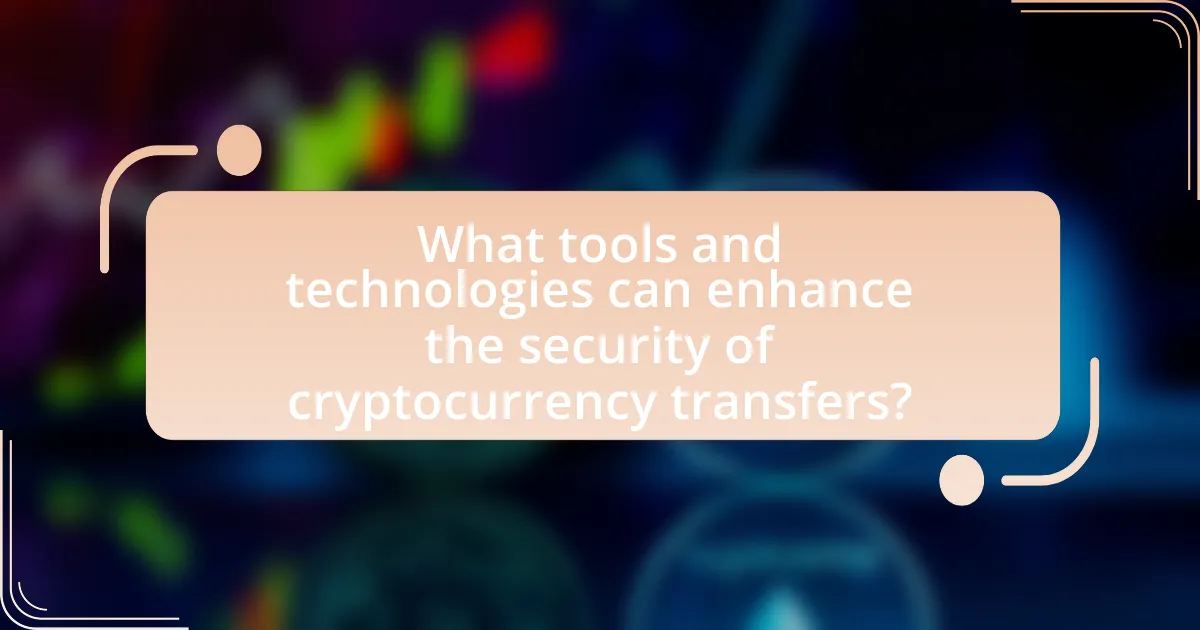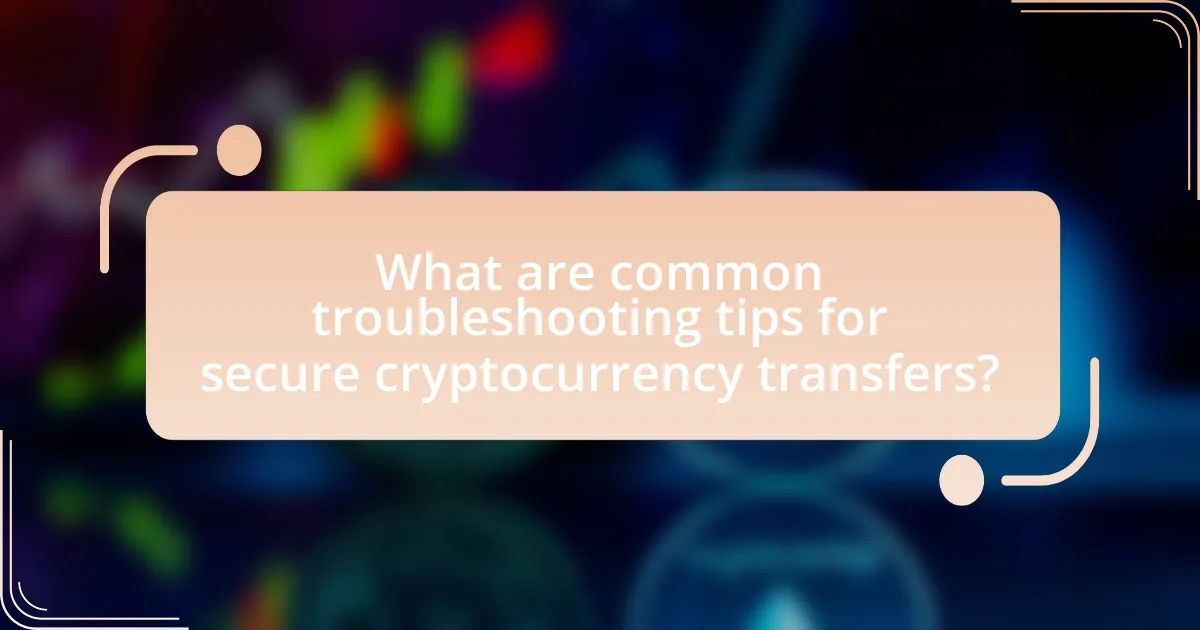Secure cryptocurrency transfer between wallets is the process of moving digital assets while ensuring transaction safety and integrity through methods like encryption and two-factor authentication. The article outlines how cryptocurrency transfers work, detailing the roles of public and private keys, the types of wallets available, and the importance of security in preventing theft and fraud. It also discusses common risks associated with transfers, best practices for secure transactions, and tools that enhance security, such as multi-signature wallets and blockchain explorers. Additionally, troubleshooting tips for failed transactions and strategies to prevent future issues are provided, emphasizing the need for robust security measures in the cryptocurrency ecosystem.

What is Secure Cryptocurrency Transfer Between Wallets?
Secure cryptocurrency transfer between wallets refers to the process of moving digital assets from one cryptocurrency wallet to another while ensuring the transaction’s safety and integrity. This process typically involves using secure methods such as encryption, two-factor authentication, and blockchain technology to protect against unauthorized access and fraud. For instance, utilizing hardware wallets, which store private keys offline, significantly reduces the risk of hacking, as evidenced by the fact that over 90% of cryptocurrency thefts occur from online wallets.
How does the process of transferring cryptocurrency work?
The process of transferring cryptocurrency involves sending digital assets from one wallet to another through a blockchain network. When a user initiates a transfer, they create a transaction that includes the recipient’s wallet address, the amount of cryptocurrency to be sent, and a digital signature to verify their identity. This transaction is then broadcasted to the network, where it is validated by miners or validators who confirm its legitimacy through consensus mechanisms. Once validated, the transaction is added to the blockchain, making it irreversible and publicly recorded. This process ensures security and transparency, as each transaction is cryptographically secured and traceable on the blockchain.
What are the different types of cryptocurrency wallets involved?
The different types of cryptocurrency wallets involved are hardware wallets, software wallets, paper wallets, and mobile wallets. Hardware wallets, such as Ledger and Trezor, store private keys offline, providing enhanced security against online threats. Software wallets, including desktop and web wallets, are applications that store private keys on devices or in the cloud, offering convenience but with varying security levels. Paper wallets involve printing the private keys on paper, which can be secure if stored properly but are susceptible to physical damage or loss. Mobile wallets, like Trust Wallet and Coinbase Wallet, are applications on smartphones that allow users to manage their cryptocurrencies on the go, balancing ease of use with security features. Each wallet type serves different user needs and security preferences, making it essential to choose the right one for securely transferring cryptocurrency.
What role do public and private keys play in transfers?
Public and private keys are essential for securely transferring cryptocurrency between wallets. The public key acts as an address that others can use to send cryptocurrency, while the private key is a secret that allows the owner to access and manage their funds. When a transfer occurs, the sender uses their private key to sign the transaction, ensuring that only they can authorize the movement of their cryptocurrency. This cryptographic signature is then verified by the network using the sender’s public key, confirming the legitimacy of the transaction. The use of public and private keys ensures that only authorized users can initiate transfers, thereby maintaining the security and integrity of the cryptocurrency system.
Why is security important in cryptocurrency transfers?
Security is crucial in cryptocurrency transfers to protect assets from theft and fraud. The decentralized nature of cryptocurrencies makes them susceptible to hacking, where attackers can exploit vulnerabilities in wallets or exchanges. For instance, in 2021, over $2.8 billion was stolen from DeFi platforms due to security breaches, highlighting the need for robust security measures. Ensuring security during transfers helps maintain user trust and the overall integrity of the cryptocurrency ecosystem.
What are the common risks associated with transferring cryptocurrency?
The common risks associated with transferring cryptocurrency include transaction errors, security vulnerabilities, and regulatory issues. Transaction errors can occur due to incorrect wallet addresses, leading to irreversible loss of funds. Security vulnerabilities arise from hacking attempts on wallets or exchanges, where private keys may be compromised, resulting in theft of assets. Regulatory issues can involve legal repercussions if the transfer violates local laws or regulations, potentially leading to fines or asset seizure. According to a report by Chainalysis, in 2021, over $7.7 billion worth of cryptocurrency was stolen, highlighting the significant risk of security breaches during transfers.
How can security breaches impact users?
Security breaches can significantly impact users by compromising their personal information and financial assets. When a security breach occurs, unauthorized individuals may gain access to sensitive data such as passwords, private keys, and financial details, leading to identity theft and financial loss. For instance, a report by the Identity Theft Resource Center indicated that in 2020, over 1,100 data breaches exposed more than 300 million records, highlighting the scale of the threat. Additionally, users may experience emotional distress and loss of trust in digital platforms, further complicating their ability to securely manage their cryptocurrency transactions.

What are the best practices for securely transferring cryptocurrency?
The best practices for securely transferring cryptocurrency include using hardware wallets, enabling two-factor authentication, and verifying recipient addresses. Hardware wallets, such as Ledger or Trezor, store private keys offline, significantly reducing the risk of hacking. Two-factor authentication adds an extra layer of security by requiring a second form of verification, making unauthorized access more difficult. Additionally, verifying recipient addresses before sending funds prevents mistakes and potential loss of assets, as blockchain transactions are irreversible. Following these practices enhances the security of cryptocurrency transfers.
How can users ensure their wallets are secure before transferring?
Users can ensure their wallets are secure before transferring by implementing strong security measures such as enabling two-factor authentication (2FA), using hardware wallets, and regularly updating software. Two-factor authentication adds an extra layer of security by requiring a second form of verification, making unauthorized access more difficult. Hardware wallets store private keys offline, significantly reducing the risk of hacking. Regularly updating wallet software ensures that users benefit from the latest security patches and features, protecting against vulnerabilities. These practices collectively enhance wallet security and reduce the likelihood of unauthorized transactions.
What security measures should be taken for hot wallets?
To secure hot wallets, implement multi-factor authentication (MFA), use strong, unique passwords, and regularly update software. Multi-factor authentication adds an extra layer of security by requiring additional verification beyond just a password, significantly reducing the risk of unauthorized access. Strong passwords, ideally generated by a password manager, prevent brute-force attacks, while regular software updates patch vulnerabilities that could be exploited by hackers. According to a report by the Cybersecurity & Infrastructure Security Agency, 80% of data breaches involve weak or stolen passwords, highlighting the importance of these measures.
What precautions are necessary for cold storage wallets?
To ensure the security of cold storage wallets, users must take several precautions. First, securely generate and store the wallet’s private keys offline, as exposure to the internet increases the risk of hacking. Additionally, users should utilize hardware wallets, which provide an extra layer of security by keeping private keys in a dedicated device. It is also crucial to create strong, unique passwords for wallet access and enable two-factor authentication where possible. Regularly updating the wallet’s firmware and software can protect against vulnerabilities. Furthermore, users should maintain physical security by storing the wallet in a safe location, such as a safe deposit box, to prevent theft or loss. These precautions are essential for safeguarding cryptocurrency assets against unauthorized access and potential loss.
What steps should be followed during the transfer process?
To securely transfer cryptocurrency between wallets, follow these steps: First, ensure that both the sending and receiving wallets are compatible with the cryptocurrency being transferred. Next, obtain the recipient’s wallet address, which is a unique identifier for their wallet. After that, initiate the transfer by entering the recipient’s address and the amount to be sent in the sending wallet’s interface. Confirm the transaction details, including any transaction fees, and then authorize the transfer. Finally, monitor the transaction status on the blockchain to ensure it is completed successfully. These steps are essential for a secure and efficient transfer process, as they minimize the risk of errors and ensure that the funds reach the intended recipient.
How can users verify the recipient’s wallet address?
Users can verify the recipient’s wallet address by cross-checking it with the recipient through a secure communication channel. This method ensures that the address has not been altered or miscommunicated. Additionally, users can utilize blockchain explorers to confirm that the wallet address is valid and has not been associated with any fraudulent activities. Blockchain explorers provide real-time data on transactions and wallet balances, allowing users to validate the address before proceeding with the transfer.
What should users do to confirm the transaction details before sending?
Users should carefully review the transaction details, including the recipient’s wallet address, the amount being sent, and any transaction fees, before sending. This ensures accuracy and prevents loss of funds due to errors. Verifying the recipient’s wallet address against known sources or using QR codes can further minimize mistakes, as a single character error can lead to irreversible transactions. Additionally, users should check the transaction summary provided by their wallet application, which typically displays all relevant details for confirmation.

What tools and technologies can enhance the security of cryptocurrency transfers?
Multi-signature wallets, hardware wallets, and blockchain analytics tools significantly enhance the security of cryptocurrency transfers. Multi-signature wallets require multiple private keys to authorize a transaction, reducing the risk of unauthorized access. Hardware wallets store private keys offline, protecting them from online threats such as hacking or malware. Blockchain analytics tools monitor transactions for suspicious activity, enabling users to identify potential fraud or theft. According to a report by Chainalysis, the use of these technologies has led to a decrease in successful hacks and increased user confidence in cryptocurrency transactions.
How do multi-signature wallets improve security?
Multi-signature wallets improve security by requiring multiple private keys to authorize a transaction, thereby reducing the risk of unauthorized access. This mechanism ensures that even if one key is compromised, the funds remain secure as additional keys are needed for transaction approval. For instance, a common configuration might require three out of five keys to sign a transaction, which significantly enhances security compared to single-key wallets. This multi-party control mitigates risks associated with theft, loss, or fraud, as it decentralizes the control of funds and requires consensus among multiple parties before any transaction can occur.
What are the benefits of using hardware wallets for transfers?
Hardware wallets provide enhanced security for cryptocurrency transfers by storing private keys offline, which significantly reduces the risk of hacking. Unlike software wallets that are connected to the internet, hardware wallets are immune to online threats, making them a safer option for managing digital assets. According to a report by the Cybersecurity & Infrastructure Security Agency, hardware wallets are considered one of the most secure methods for storing cryptocurrencies due to their ability to keep sensitive information isolated from potential cyber attacks.
What role do blockchain explorers play in tracking transfers?
Blockchain explorers serve as essential tools for tracking transfers by providing real-time access to transaction data recorded on a blockchain. They allow users to input transaction IDs or wallet addresses to view detailed information about each transfer, including timestamps, amounts, and the status of transactions. This transparency is crucial for verifying the legitimacy of transfers and ensuring that funds have been successfully sent or received. For instance, Bitcoin blockchain explorers can show the confirmation status of a transaction, which is vital for users to confirm that their cryptocurrency transfer has been completed.
How can users utilize blockchain explorers to verify transactions?
Users can utilize blockchain explorers to verify transactions by entering the transaction ID or wallet address into the search bar of the explorer. This action allows users to access detailed information about the transaction, including its status, confirmation count, and associated timestamps. Blockchain explorers provide real-time data directly from the blockchain, ensuring that users can confirm whether a transaction has been successfully processed or is still pending. This verification process is crucial for ensuring the security and accuracy of cryptocurrency transfers, as it allows users to track their transactions transparently and independently.

What are common troubleshooting tips for secure cryptocurrency transfers?
Common troubleshooting tips for secure cryptocurrency transfers include verifying wallet addresses, ensuring sufficient network fees, and confirming transaction status. Verifying wallet addresses prevents sending funds to incorrect or fraudulent addresses, which is crucial since transactions are irreversible. Ensuring sufficient network fees is important because low fees can lead to delayed transactions or failures in processing. Confirming transaction status through blockchain explorers allows users to track their transfers and identify any issues promptly. These practices enhance the security and reliability of cryptocurrency transfers.
What should users do if a transaction fails or is delayed?
If a transaction fails or is delayed, users should first check the transaction status on the blockchain explorer to confirm its current state. This step allows users to determine whether the transaction is pending, failed, or confirmed. If the transaction is still pending, users should wait for a reasonable amount of time, as network congestion can cause delays. If the transaction has failed, users should verify the transaction details, such as the recipient address and gas fees, and then attempt to resend the transaction with the correct information. Additionally, users should consult their wallet provider’s support resources for specific troubleshooting steps related to their platform.
How can users recover funds from a failed transaction?
Users can recover funds from a failed transaction by contacting their cryptocurrency exchange or wallet provider for assistance. Most exchanges have specific protocols in place for handling failed transactions, which may include verifying the transaction status and initiating a reversal or refund process. For example, if a transaction fails due to insufficient funds or network issues, users should provide transaction details, such as transaction ID and timestamps, to facilitate the recovery process. Additionally, users should check their wallet’s transaction history to confirm the failure and gather necessary information for support.
What steps can be taken to prevent future transfer issues?
To prevent future transfer issues when securely transferring cryptocurrency between wallets, users should implement multi-factor authentication (MFA) on their wallets. MFA adds an extra layer of security by requiring additional verification steps beyond just a password, significantly reducing the risk of unauthorized access. According to a study by the Cybersecurity & Infrastructure Security Agency, enabling MFA can prevent 99.9% of automated attacks, highlighting its effectiveness in safeguarding digital assets. Additionally, users should regularly update their wallet software to patch vulnerabilities and utilize hardware wallets for enhanced security against online threats.